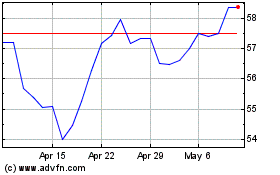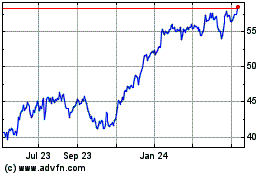Revised 'Living Wills' Released for Five Big U.S. Banks -- 2nd Update
October 04 2016 - 5:03PM
Dow Jones News
By Donna Borak
WASHINGTON -- U.S. regulators on Tuesday made public new plans
submitted by five of the biggest U.S. banks explaining how they
could wind down their operations in a period of extreme distress
without requiring a taxpayer bailout.
The government required the plans, called "living wills," to be
submitted after declaring in April that earlier versions from the
institutions weren't sufficiently credible. The five banks are J.P.
Morgan Chase & Co., Wells Fargo & Co., Bank of America
Corp., Bank of New York Mellon Corp., and State Street Corp.
In releasing the documents, the Federal Reserve and the Federal
Deposit Insurance Corp. said in a joint press release that they had
no assessment yet of the documents and hadn't yet reviewed them.
They said they "will now be initiating their process for
review."
The documents that were made public -- about 50 pages each --
were just a small portion of the full filings made by the
institutions. Much-longer private documents containing detailed
confidential information were also submitted to the agencies.
The regulators also released documents submitted by three other
banks, whose plans cleared the regulatory assessment in April, but
which submitted updates on their blueprints: Goldman Sachs Group
Inc., Morgan Stanley and Citigroup Inc.
The living-will submissions are part of the extensive list of
new requirements imposed on big banks after the financial crisis,
when the government bailed out the country's largest banks, aiming
to prevent an even deeper collapse, but stoking a widespread
political backlash.
As part of the 2010 Dodd-Frank financial-overhaul law, big banks
are required to submit detailed plans convincing the Fed and FDIC
they have credible plans for failing without costing taxpayers a
dime.
If the regulators feel that the plans aren't sufficient, they
have the power to order the banks to increase their capital
cushions to guard against further losses, and, eventually, to order
an extensive restructuring of their operations, including shedding
certain business lines.
In its 58-page public document, J.P. Morgan Chase said it put
together "a robust legal analysis of potential creditor and
fiduciary challenges to capital and liquidity support." Based on
that analysis, the bank decided to "immediately establish, and
begin transferring assets into, an intermediate holding
company."
As part of the planning, the financial institutions group in
J.P. Morgan's investment bank conducted an "expert analysis" to
objectively identify and analyze possible "objects of sale." It
found 16 along with potential buyers for each. It has a divestiture
playbook for each of those possible sales.
--Emily Glazer contributed to this article.
Write to Donna Borak at donna.borak@wsj.com
(END) Dow Jones Newswires
October 04, 2016 16:48 ET (20:48 GMT)
Copyright (c) 2016 Dow Jones & Company, Inc.
Bank of New York Mellon (NYSE:BK)
Historical Stock Chart
From Mar 2024 to Apr 2024

Bank of New York Mellon (NYSE:BK)
Historical Stock Chart
From Apr 2023 to Apr 2024
